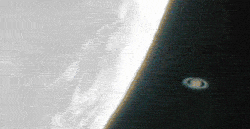
The occultation of Saturn by the Moon
Due to the large angular diameter of the Moon, one refers usually to it when speaking about occultations. For a terrestrial observer the monthly revolution of our satellite successively covers stars (daily) and planets (once in a while). These stars are occulted or hidden during a certain amount of time, implying the name of the phenomenon.
Some occultations are visible with the naked eye. In the old chronicles, it is possible to find mentions of these phenomena. Those data are rather interesting to check the moon's tables.
The observation of the occultation by the Moon simply consists in noting the hour of disappearance and of reappearance of the star that it is hiding. The observation is generally possible only for the most brilliant stars. In fact, the very brilliant Moon makes that the weaker stars disappear by contrast. This difficulty disappears during the total eclipses, the disc of the Moon being then almost as perceptible, the observations can be multiplied. The astronomers used such exceptional circumstance to determine of the real size of the lunar disc, which remained difficult to measure in a very precise way for a long time, only one edge being generally lit and additional diffraction disturbing the observations. The diameter of the Moon deduced from a great number of occultations is approximately 4 " lower than that provided by direct measurements.
Before in situ measurements could be carried out during the Apollo missions, occultation measurements proved that the density of the Moon's atmosphere was almost null. The lunar atmosphere could be considered, according to these studies, at about 900 times less dense than the Earth's atmosphere. Various other data led to the same conclusion.